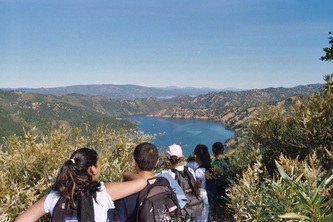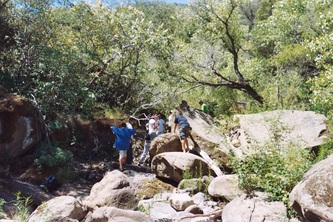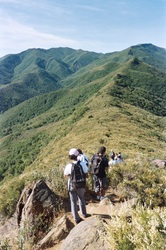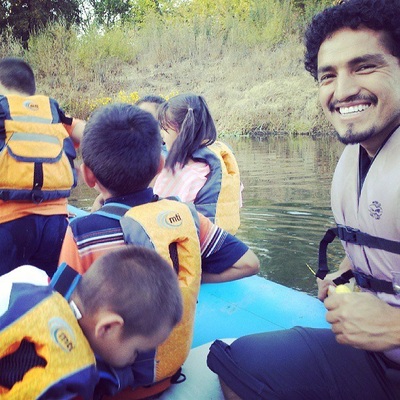Environmental Education
Working to inform students about the environment through outdoor and indoor learning. Stay tuned for more upcoming work.
Selected Writings
Aprendiendo in the Outdoors
We highlight getting to the Outdoors for a wide range of benefits, especially relating to physical and cognitive health.
But a recent story by the National Wildlife Federation noted another key benefit in getting more Latino youth to the Outdoors. As the article notes:
“Perez Elementary School, a registered Eco-School in Austin, Texas and recent winner of a Children in Nature Collaborative of Austin award for environmental education, reminds us that green schools help close the achievement gap for low income and minority students as well as protect the planet and lower energy costs. The student body at Perez is 86 percent Hispanic and 93 percent low income, and the school has made steady academic progress by taking learning outside.”
We have had outdoor schools and environmental education for decades. But there is a difference in what all the different categories mean. Outdoor schools can mean many things, and though in general it can mean education taking place in the outdoors, they tend to be associated with physical skills and “adventure” related programming. Environmental Education is usually related to learning about the environment and conservation issues, with some schools even specifying as being outdoor science schools. To that we have added nature education and “eco-schools”.
But a general take-away point to note is that the Outdoors can serve not just as a place to learn, but also as a subject to learn, and as a platform for integrated learning of all subjects.
It is not so much that this simply becomes a substitute for learning indoors at school, but that rather it can serve as a key alternative for students that struggle with the “standard classroom” environment.
This is crucial for Latinos and other students of color, which have high rates of dropping out and low academic achievement (though that may be changingrecently).
Several years ago, a major study in California studied the effects of Outdoor School programs. The findings pointed to academic gains in the classroom, especially in Latino Students. Along with a host of other benefits like conflict resolution and environmental behaviors, students “who attended outdoor school programs significantly improved their science scores by 27 percent, as measured by a pre- and post-survey.”
As the NWF article also notes:
“Evaluations of environmental education programs in Florida and Texas confirm that economically disadvantaged, Hispanic, and African-American students see the biggest academic benefits from outdoor learning.”
“Perhaps the best news is that green schools make learning fun and engaging at the same time that they boost academic performance. Learning and exploring outdoors, students come into contact with natural things that elicit a deep emotional response.”
So results across the board seem very promising for Latino students. What would be next steps?
Some ideas are to make sure that these programs serve as examples for other education programs. At the same time, it should be relevant and worthy to ask how the programs are culturally relevant and connect with the familias. This can help inform programs that struggle to connect with the very communities that can benefit the most.
Part of this is to also think how the programs reflect the diversity of the communities they serve—specifically a question would be: what is the diversity of outdoor and environmental education teachers?
This would not be to indicate that Latino students cannot learn from non-Latino teachers, but it would be important to explore how cultural leadership and role models are available in this field.
Again, all of this matters, because using the Outdoors can be a powerful connection for Latinos in STEM (Science, Technology, Engineering, Mathematics) fields and other careers in conservation, a need that has already been established. You can see sample models such as the work being done theCalifornia Mini-Corps Program and Environment for the Americas.
So work is being done, there is an interest, and there are benefits. We just need to continue pushing forward, pa delante.
As a closing statement, we need to ensure we have a conserved Outdoors to serve as an education platform. But that will be a post for another day.
We highlight getting to the Outdoors for a wide range of benefits, especially relating to physical and cognitive health.
But a recent story by the National Wildlife Federation noted another key benefit in getting more Latino youth to the Outdoors. As the article notes:
“Perez Elementary School, a registered Eco-School in Austin, Texas and recent winner of a Children in Nature Collaborative of Austin award for environmental education, reminds us that green schools help close the achievement gap for low income and minority students as well as protect the planet and lower energy costs. The student body at Perez is 86 percent Hispanic and 93 percent low income, and the school has made steady academic progress by taking learning outside.”
We have had outdoor schools and environmental education for decades. But there is a difference in what all the different categories mean. Outdoor schools can mean many things, and though in general it can mean education taking place in the outdoors, they tend to be associated with physical skills and “adventure” related programming. Environmental Education is usually related to learning about the environment and conservation issues, with some schools even specifying as being outdoor science schools. To that we have added nature education and “eco-schools”.
But a general take-away point to note is that the Outdoors can serve not just as a place to learn, but also as a subject to learn, and as a platform for integrated learning of all subjects.
It is not so much that this simply becomes a substitute for learning indoors at school, but that rather it can serve as a key alternative for students that struggle with the “standard classroom” environment.
This is crucial for Latinos and other students of color, which have high rates of dropping out and low academic achievement (though that may be changingrecently).
Several years ago, a major study in California studied the effects of Outdoor School programs. The findings pointed to academic gains in the classroom, especially in Latino Students. Along with a host of other benefits like conflict resolution and environmental behaviors, students “who attended outdoor school programs significantly improved their science scores by 27 percent, as measured by a pre- and post-survey.”
As the NWF article also notes:
“Evaluations of environmental education programs in Florida and Texas confirm that economically disadvantaged, Hispanic, and African-American students see the biggest academic benefits from outdoor learning.”
“Perhaps the best news is that green schools make learning fun and engaging at the same time that they boost academic performance. Learning and exploring outdoors, students come into contact with natural things that elicit a deep emotional response.”
So results across the board seem very promising for Latino students. What would be next steps?
Some ideas are to make sure that these programs serve as examples for other education programs. At the same time, it should be relevant and worthy to ask how the programs are culturally relevant and connect with the familias. This can help inform programs that struggle to connect with the very communities that can benefit the most.
Part of this is to also think how the programs reflect the diversity of the communities they serve—specifically a question would be: what is the diversity of outdoor and environmental education teachers?
This would not be to indicate that Latino students cannot learn from non-Latino teachers, but it would be important to explore how cultural leadership and role models are available in this field.
Again, all of this matters, because using the Outdoors can be a powerful connection for Latinos in STEM (Science, Technology, Engineering, Mathematics) fields and other careers in conservation, a need that has already been established. You can see sample models such as the work being done theCalifornia Mini-Corps Program and Environment for the Americas.
So work is being done, there is an interest, and there are benefits. We just need to continue pushing forward, pa delante.
As a closing statement, we need to ensure we have a conserved Outdoors to serve as an education platform. But that will be a post for another day.

























